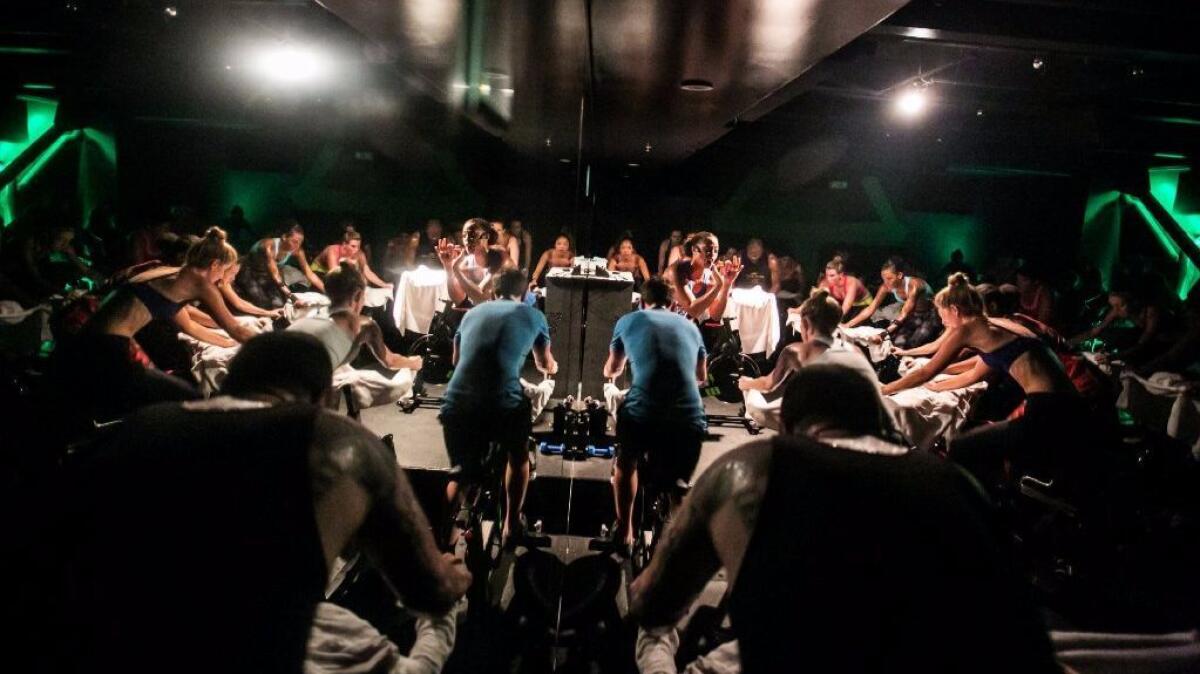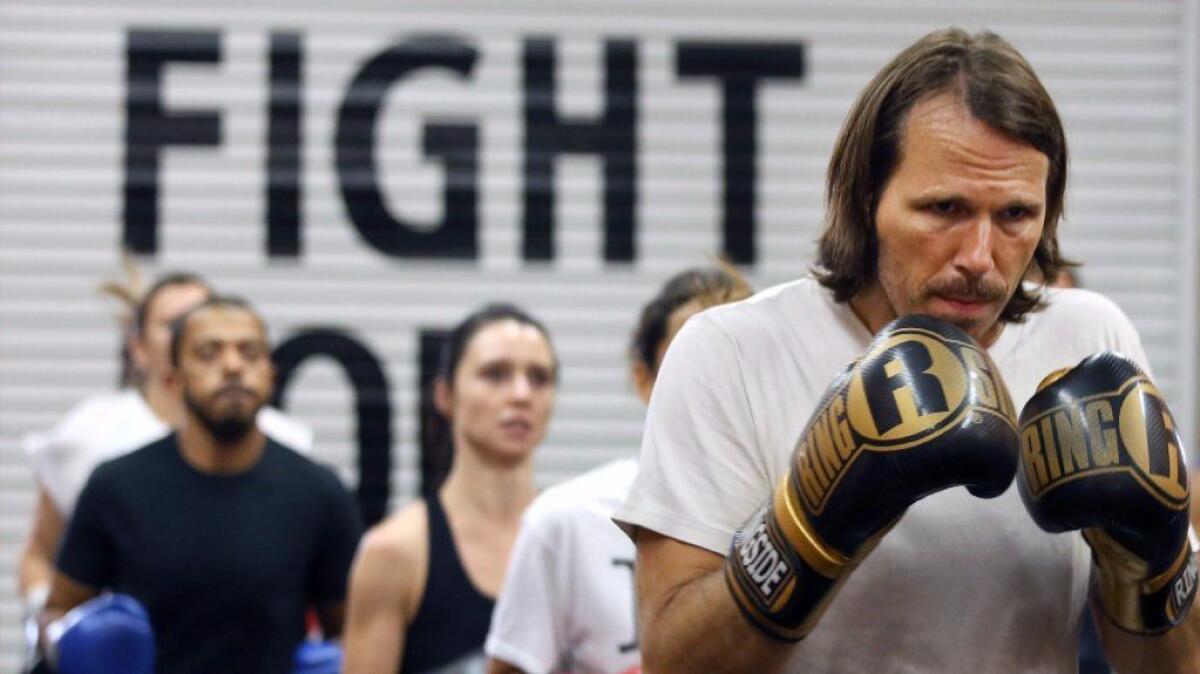Millennials are spending big on trendy places to sweat

Millennials and are choosing trendy, expensive boutique fitness studios over regular gyms. Instructor Kendall Wood leads the boxing fitness class at Prevail Boxing in Los Angeles. (Glenn Koenig/Los Angeles Times)
- Share via
Carla Zuniga is punching a heavy bag as if she were preparing for a title fight, although she’s really a 35-year-old hair stylist doing her regular workout.
Zuniga isn’t sweating at some low-fee, big-box fitness chain. Prevail Boxing is a 1,500-square-foot studio in Los Angeles that charges $250 for 10 classes.
“I think people in my generation are more willing to invest in what challenges them and makes them healthy,” said Zuniga, who grew bored with cheaper, traditional gyms. “It’s expensive to be healthy, but it’s more expensive to be sick.”
Costly coffee and artisanal avocado toast may be getting the blame for millennials’ inability to afford a house. But those expenses pale compared with what a growing segment is willing to spend on fitness, abandoning $30-a-month gyms for trendy studios where classes for cycling, boot camp or yoga can run $30 a session.
Boutique fitness studios have become the only growth segment in an otherwise stagnant gym industry, according to separate research reports from the Assn. of Fitness Studios, fitness technology firm Netpulse and financial services firm Stephens.
“When it comes to the younger generation, consumer items like car and home purchases are at an all-time low,” said Greg Skloot, vice president for growth at Netpulse, a San Francisco company that creates mobile apps for health clubs.
“They don’t want an annual gym membership commitment and a contract,” said Skloot, who co-wrote a recent report on fitness industry changes titled “The Club of 2020.” “They want to be able to make physical fitness choices on demand, and they are willing to pay for it.”
Spurred by popular startup ClassPass and other online middlemen, young fitness addicts say their days of mindless treadmill workouts tied to just one gym are over. With a limited number of spots per class and advance reservations generally required, there’s a mad rush to get into the hottest classes.
Rules can be strict where studios have waiting lists of a dozen or more people who are hoping someone doesn’t show up for a class so that they can slip into the spot.
At Prevail Boxing, for instance, cancellations with less than eight hours’ notice cost $10 on top of the price of the class. Fail to show and there’s a $20 fee. Arrive less than five minutes early and you stand a chance of losing your class spot to someone else.

People sign up as early as two weeks in advance for a coveted spot with a sought-after trainer such as Cycle House’s Nichelle Hines, whose title is chief ride officer. Some instructors and owners have become celebrities themselves, with reality TV shows and hundreds of thousands of Instagram followers.
Bart Kwan, 33, has 472,000 Instagram followers and 674,000 YouTube subscribers. Kwan regularly posts comedy and power-lifting workout videos that garner more than 1 million views each. Kwan’s “Justkiddingnews” YouTube channel has nearly 1.7 million subscribers.
Kwan, a former athlete who also practiced mixed martial arts, wasn’t happy at traditional gyms. So he and his wife, Geo, opened Barbell Brigade near downtown Los Angeles in 2013. It’s not as expensive as some boutique gyms, with a day pass costing $20 and the monthly fee for regulars running $100.
Kwan said he wanted to re-create the atmosphere he once found in a mixed martial arts training facility.
“We were paying top dollar to go there,” Kwan said, “but we considered that place our temple.”
Grid Vongpiansuksa tried Barbell Brigade in 2014 and came back for the support.
“Sure, it’s expensive,” the 22-year-old said, “but in an environment like this, people are encouraging you, so it becomes you investing in the best you can be.”
Boutique fitness studios mix small-group camaraderie and dojo-like commitment with coconut water and their own branded merchandise, such as Barbell Brigade’s line of Dominate Humbly products and attire.
Instead of the professional athlete and bodybuilder photos that line the walls of some traditional gyms, there are selfie walls perfect for the Instagram-obsessed.

Skloot and other experts say the social aspect partially explains the willingness to pay so much more than at a traditional gym. Millennials may be ready to forgo an alternative social activity — going out for dinner and drinking and dancing, for example — where the cost can easily run $100 or more.
“You see your friends at the gym,” Zuniga said, “and the next morning you don’t wake up feeling awful. You wake up feeling great.”
At Cycle House, which specializes in demanding cycling classes, it’s not unusual to see members lingering outside in the courtyard and at the adjacent coffee shop. But the difficulty of the classes is the real draw, said Peter Marcos, a customer who liked Cycle House so much he quit his tech job to work there.
Customers don’t want regular maintenance-style workouts reasonably certain to keep you in decent shape. They want to be tested, drained.
“I was sold after my first ride here,” Marcos said. “I came out completely refreshed and empowered.”
That kind of challenge draws Los Angeles actress Aisha Kabia, who said she was able to afford a Cycle House class only by using ClassPass, a membership service that offers discounts on classes at multiple studios.
“It’s exposed me to classes that I probably would not have been able to go to because of finances. A meditation studio, hot yoga,” said Kabia, whose biggest recent credit was playing a lawyer in 2017’s “Transformers: The Last Knight.”
We understand that this costs a lot of money for people, but this place has become part of their social activity.
— Bert Culha, Cycle House co-owner
Payal Kadakia, an MIT graduate and a lifelong dancer, said she created ClassPass to inspire fitness by giving customers options for different athletic experiences.
Kadakia’s first entry into fitness, Classtivity, was a pay-per-class model that didn’t catch on. She rebranded, brought in more seed money and changed to a monthly membership model for ClassPass, which has become a $470-million operation.
ClassPass kicked off in New York four years ago with unlimited classes for $99 a month. Later, ClassPass increased prices and ditched the all-you-can-eat model, sparking some customer backlash.
“The company’s been through a few transitions, as any company does, in terms of figuring out its product market niche,” Kadakia, 34, said.
“We have 8,000 partners globally at this point and you can use your classes anywhere. Many of these studio owners are looking for new customers to walk in the door, and that’s why this really works,” she said.
Cycle House got an immediate infusion of customers from ClassPass, said Bert Culha, who owns the club with husband-and-wife team Adam and Lara Gillman.
“We understand that this costs a lot of money for people, but this place has become part of their social activity because a lot of our members switched from going out and partying to going out to take care of their bodies,” Culha said.

Prevail Boxing took a different route, founder Milan Costich said. He decided to piggyback off the growing popularity of Instagram and approached a model named Kyra Santoro, who then had about 200,000 followers.
Costich asked Santoro to try his workout and, if she liked it, post about it on Instagram. She did.
“The fast-paced circuit training keeps your heart rate up,” said Santoro, 24, who has modeled in Maxim and Sports Illustrated and is now approaching 1 million Instagram followers.
Shortly after her post about Prevail, Costich recalled, a largely female crowd of millennials started coming to his gym. Costich, whose two-person staff has expanded to nearly 20, said Prevail has 350 regular members and 1,000 unique gym visits a month.
Customers don’t mind paying a premium for a “richer experience,” Costich said.
As for old-school, full-service gyms, they’re borrowing pages from the boutique studios’ playbook.
The Gold’s Gym chain, for instance, recently debuted what it calls Gold’s Studio in 40 of its nearly 740 locations and plans to invest heavily in spreading the concept, which “allows members to experience coach-led, community-driven and individually adapted boutique-style classes.”
The Assn. of Fitness Studios noted such moves in a recent study.
“Watch some of the big box boys create studio-in-the-club environments, while others decide to open their own studios, either as brand extensions or completely new business models,” the trade group concluded in its study. “No sense letting those profitable training dollars leave forever.”
To read the article in Spanish, click here
For more business news, follow Ronald D. White on Twitter: @RonWLATimes
ALSO
Will eye damage follow the Great American Eclipse?
Target is shedding Merona and Mossimo and adding new brands instead
Depressed but can’t see a therapist? This chatbot could help
When she interviewed for a dishwashing job, Lina Hu got a $40-million idea
Wal-Mart and Google team up on voice-activated shopping, challenging Amazon
More to Read
Inside the business of entertainment
The Wide Shot brings you news, analysis and insights on everything from streaming wars to production — and what it all means for the future.
You may occasionally receive promotional content from the Los Angeles Times.











